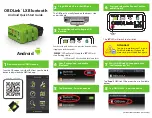
12-1
IM 2560A-01EN
Programming Overview
3
2
1
4
5
6
7
8
9
10
11
12
13
14
15
16
App
Index
Program Message Unit Syntax
The program message unit syntax is shown below.
,
<Program header>
<Program data>
Space
<Program Header>
The program header indicates the command type. For
details, see section 12.2.
<Program Data>
Attach program data if there are conditions that are
required to execute a command. Separate the program
data from the header with a space (ASCII code 20H). If
there are multiple sets of program data, separate each
set with a comma.
For details, see section 12.4.
Example
:SOURce:LEVel 1V<PMT>
Header
Data
Response Messages
The response message syntax is as follows:
<RMT>
;
<Response message unit>
<Response Message Unit>
A response message consists of one or more response
message units. Each unit corresponds to one
response.
Separate each response message unit with a
semicolon.
For details on the response message syntax, see the
next page.
Example
Unit 1
Unit 2
:SOURCE:FUNCTION VOLTAGE;
RANGE 10V
<RMT>
RMT is a response message terminator. It is
NL^END
.
Messages
Messages are used to exchange information between
the controller and the 2560A. Messages that are sent
from the controller to the 2560A are called program
messages, and messages that are sent from the 2560A
back to the controller are called response messages.
If a program message contains a command that
requests a response (a query), the 2560A returns
a response message upon receiving the program
message. The 2560A returns a single response
message in response to a single program message.
Program Messages
The program message format is shown below.
<PMT>
;
<Program message unit>
<Program Message Unit>
A program message consists of one or more program
message units. Each unit corresponds to one
command. The 2560A executes the commands in the
order that they are received.
Separate each program message unit with a
semicolon.
For details on the program message syntax, see the
next section.
Example
Unit
Unit
:SOURce:FUNCtion VOLTage; :SOURce:LEVel lV
<PMT>
This is a program message terminator. The following
three types are available.
NL (new line): Same as LF (line feed). ASCII code
“0AH.”
^END
:
The END message as defined by IEEE
488.1
(The data byte that is sent with the END
message is the last data byte of the
program message.)
NL^END
:
NL with an END message attached.
(NL is not included in the program
message.)
12.1 Messages
Chapter 12 Programming Overview
















































